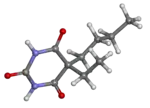Butobarbital
 | |
 | |
| Clinical data | |
|---|---|
| Trade names | Soneryl |
| AHFS/Drugs.com | International Drug Names |
| Routes of administration | Oral |
| ATC code | |
| Legal status | |
| Legal status |
|
| Pharmacokinetic data | |
| Metabolism | Hepatic |
| Excretion | Renal |
| Identifiers | |
IUPAC name
| |
| CAS Number |
|
| PubChem CID | |
| DrugBank |
|
| ChemSpider |
|
| UNII | |
| KEGG |
|
| ChEMBL | |
| CompTox Dashboard (EPA) | |
| ECHA InfoCard | 100.000.928 |
| Chemical and physical data | |
| Formula | C10H16N2O3 |
| Molar mass | 212.249 g·mol−1 |
| 3D model (JSmol) | |
SMILES
| |
InChI
| |
| (verify) | |
Butobarbital, also called butobarbitone or butethal, Soneryl, and Neonal,[1] is a hypnotic drug which is a barbiturate derivative.[2] It was developed by Poulenc Brothers (now part of Rhône Poulenc) in 1921.[3]
References
- ↑ International Drug Names
- ↑ Nordegren T (2002). "Butobarbital". The A-Z encyclopedia of alcohol and drug abuse. Parkland, Fla.: Brown Walker Press. p. 144. ISBN 978-1-58112-404-0.
- ↑ DE 481129, "Verfahren zur Herstellung von n-Butylaethylbarbitursaeure", published 3 February 1922, issued 14 August 1929, assigned to ETS Poulenc Freres.
| Alcohols |
|
|---|---|
| Barbiturates |
|
| Benzodiazepines |
|
| Carbamates | |
| Flavonoids |
|
| Imidazoles | |
| Kava constituents |
|
| Monoureides |
|
| Neuroactive steroids |
|
| Nonbenzodiazepines | |
| Phenols | |
| Piperidinediones | |
| Pyrazolopyridines | |
| Quinazolinones | |
| Volatiles/gases |
|
| Others/unsorted |
|
See also: Receptor/signaling modulators • GABA receptor modulators • GABA metabolism/transport modulators | |
This article is issued from Offline. The text is licensed under Creative Commons - Attribution - Sharealike. Additional terms may apply for the media files.